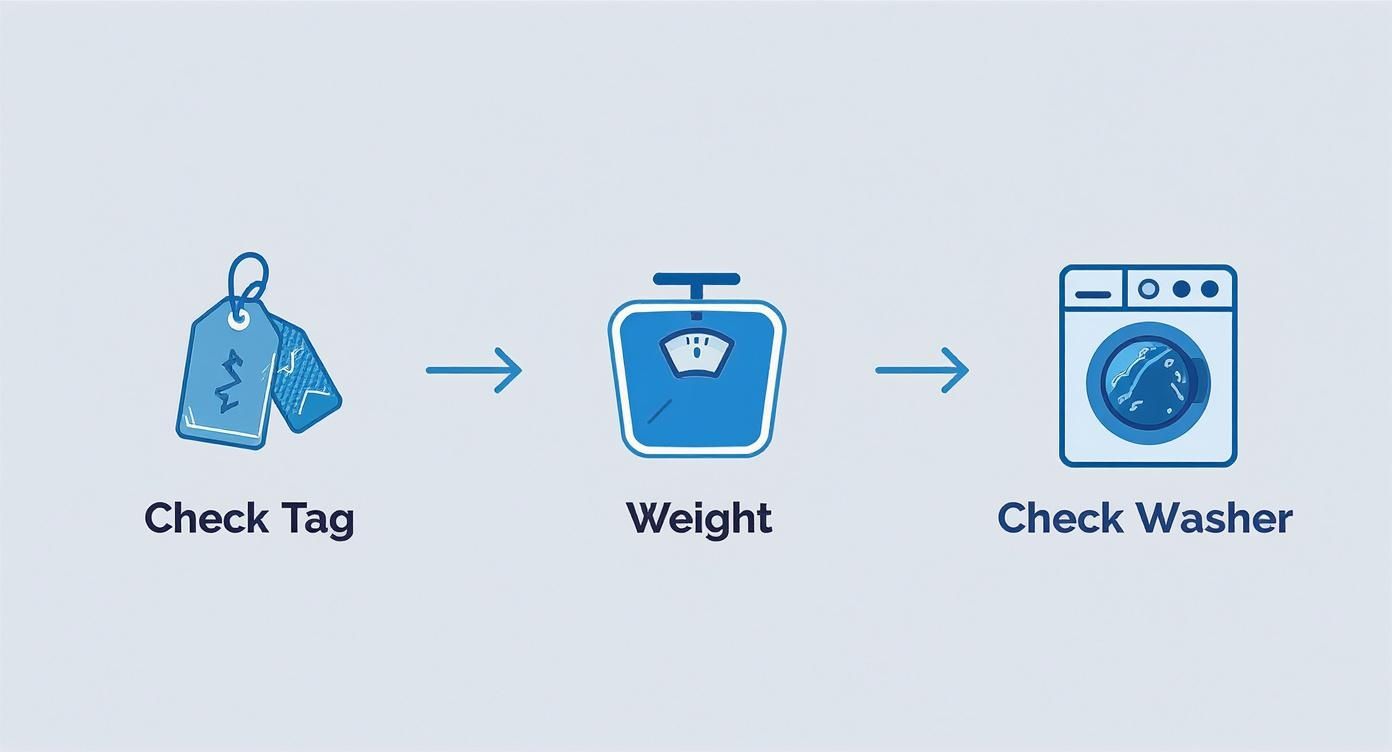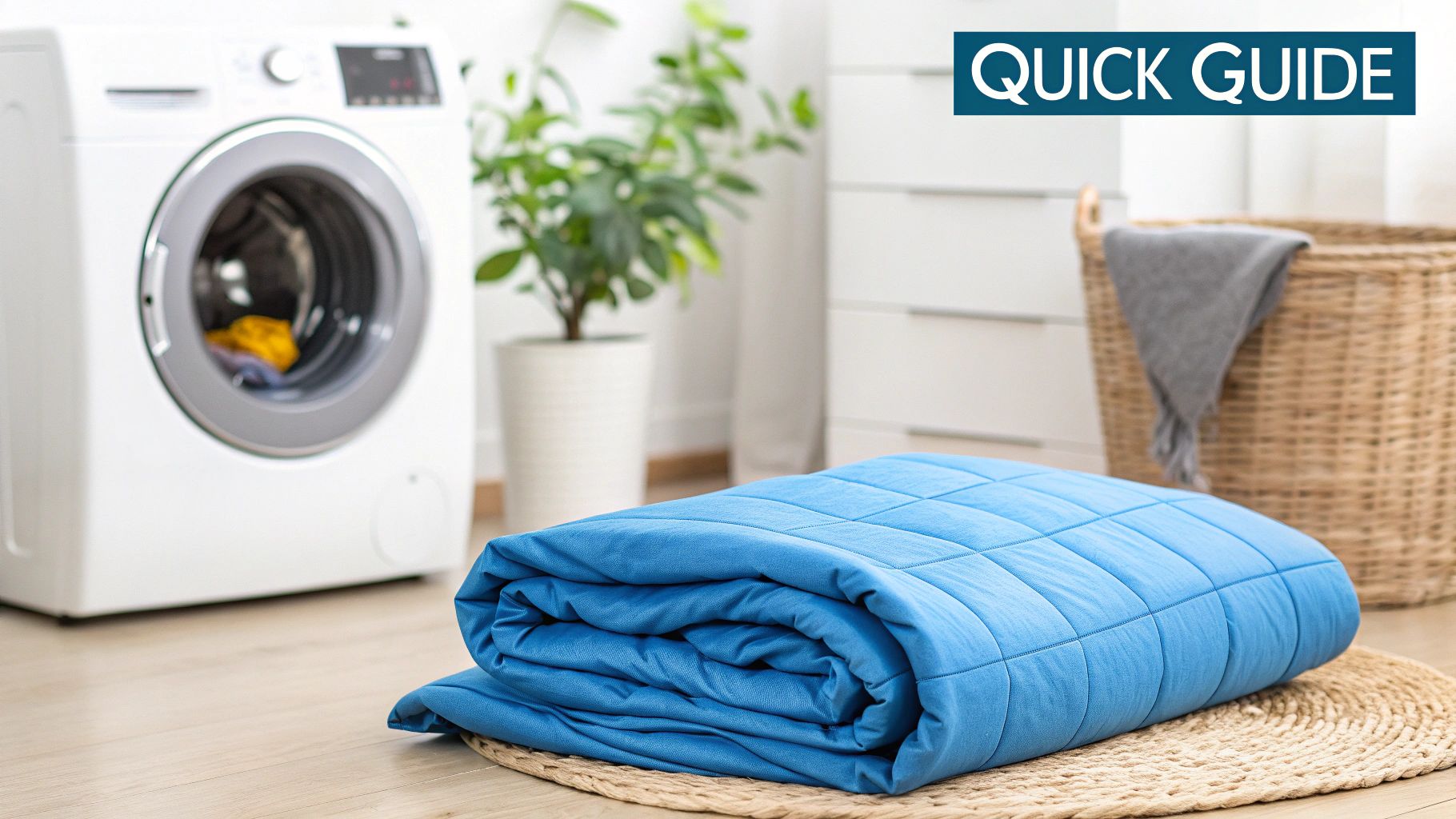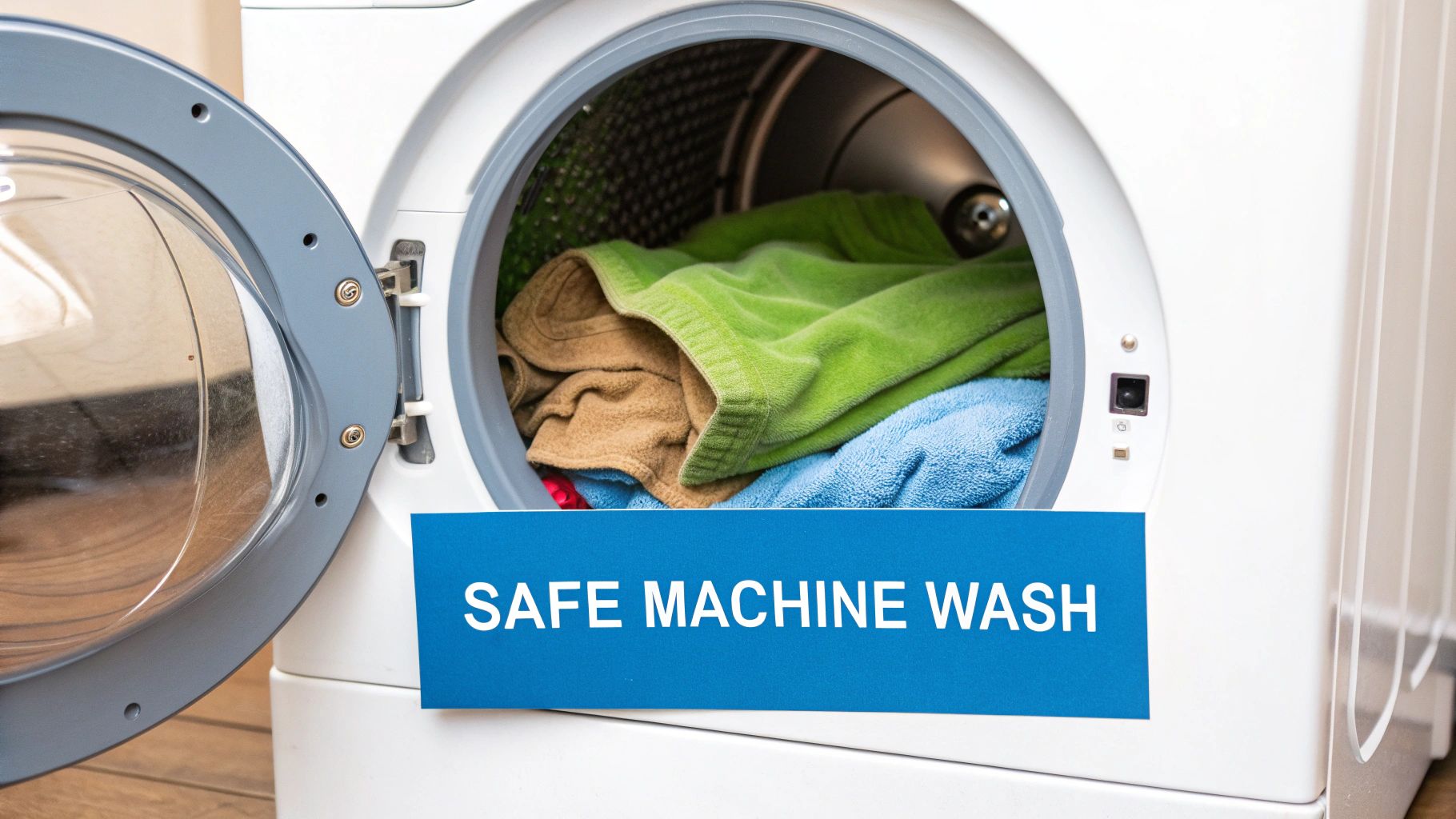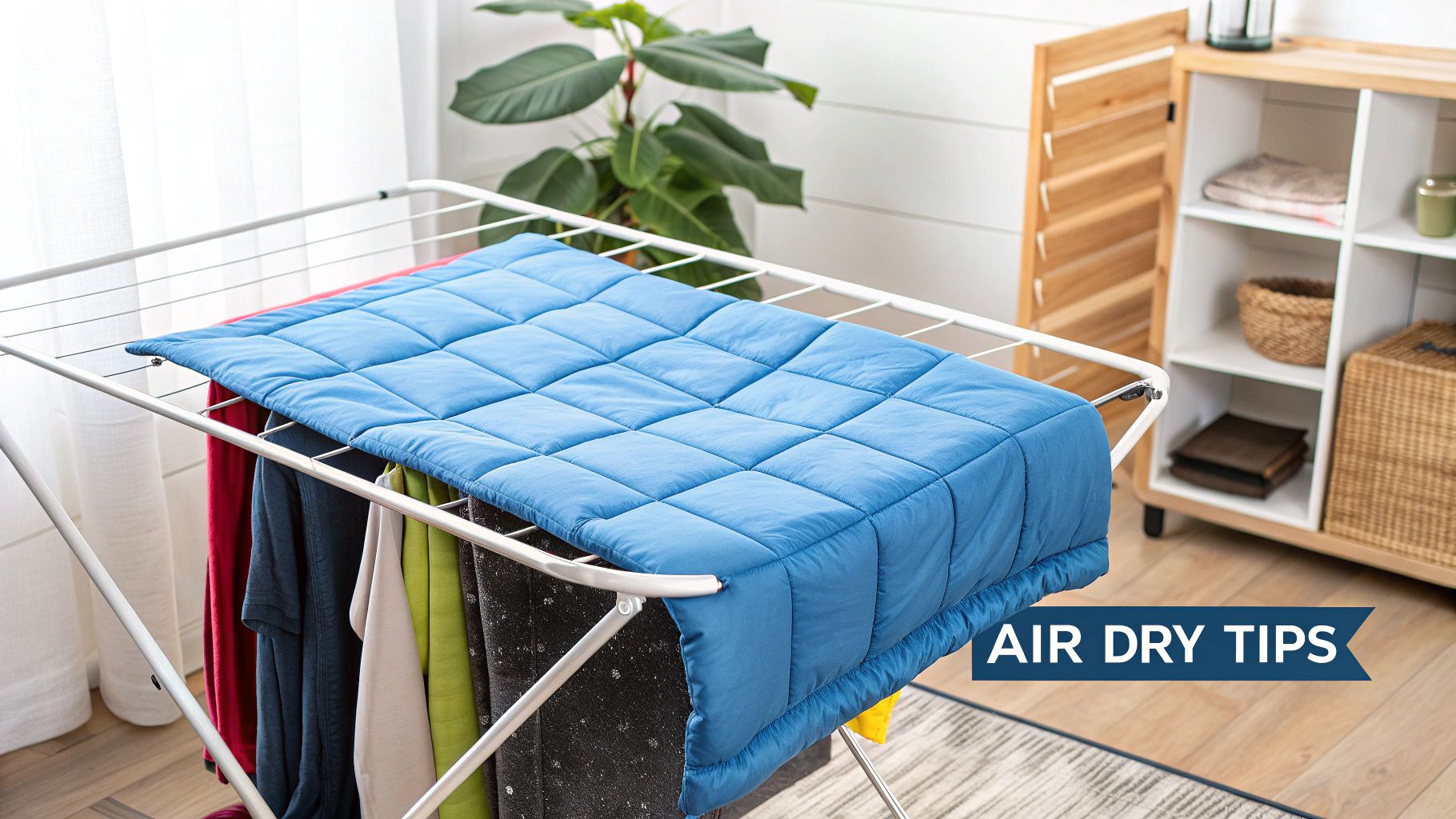Washing a weighted blanket isn't quite like tossing a regular throw in the laundry.Given its heft and special construction, there are a few things you absolutely need to check first to avoid damaging the blanket—or worse, your washing machine.
The big picture is pretty simple: read the tag, know your machine's limits, and stick to a gentle cycle with cold water. If your blanket is over 20 pounds, your best and safest option is heading to a laundromat to use a heavy-duty commercial machine. And a golden rule to remember: never use fabric softener or bleach. These chemicals are notorious for breaking down the fabric and filler material over time.
Your Quick Guide to Washing a Weighted Blanket
Before your blanket gets anywhere near the water, a few quick checks are in order. Skipping these can lead to a lumpy, damaged blanket or a busted washer, and nobody wants that. The goal here is simple: get it clean while keeping the weight evenly distributed and the fabric in great shape.
A lot of people make the mistake of assuming any weighted blanket can go into a standard home washing machine. That's a fast track to an expensive repair bill. A blanket that’s too heavy can completely overwhelm the motor and drum.
Key Pre-Wash Considerations
First things first, find that care tag. Seriously. That little label is your roadmap, giving you the manufacturer's direct instructions for water temperature, cycle type, and how to dry it properly. If you’ve snipped it off or it's faded into oblivion, the default safe-play is always a cold wash on the most delicate cycle your machine offers.
To make sure you've covered all your bases, run through this quick pre-wash checklist. It's a simple way to prevent the most common mishaps.
Pre-Wash Checklist for Your Weighted Blanket
| Check | Why It's Important | What to Look For |
|---|---|---|
| Care Tag | This is the manufacturer's specific advice. Following it prevents damage and may be required for your warranty. | Look for symbols or text indicating water temperature, cycle type (gentle/delicate), and drying instructions. |
| Blanket Weight | Your home washer has a weight limit. Exceeding it can strain or break the motor and drum. | Confirm the blanket's weight. Anything over 20 pounds is generally too heavy for a home machine. |
| Machine Capacity | The blanket needs room to move freely to get clean and rinse properly. An overstuffed machine won't wash effectively. | Ensure the blanket doesn't fill more than 2/3 of the drum. If it's a tight squeeze, it's too big. |
| Fabric & Seams | Small tears or loose threads can become major problems during a wash cycle, potentially leaking filler beads. | Do a quick visual inspection for any rips, loose stitching, or weak spots. Repair them before washing. |
Going through these steps might seem tedious, but it’s the best way to ensure your weighted blanket stays in perfect condition for years to come.
This decision tree gives you a great visual for the process.

As you can see, it really boils down to three critical steps: checking the tag, confirming the weight, and making sure your washer can handle it. Nail these three things, and you'll avoid the most common weighted blanket washing mistakes.
First Check Your Blanket's Materials

Before you toss your weighted blanket in the wash, hold on. Not all blankets are created equal, and knowing exactly what you're working with is the first—and most important—step. The entire cleaning process hinges on two key things: the outer fabric and the inner filler.
Think about the outer shell. It could be a breathable cotton, smooth bamboo, or a super-cozy minky or fleece. Each one reacts differently to heat and agitation. A sturdy cotton blanket, for example, can usually handle a standard machine wash just fine. But that soft minky fabric? It needs a gentler touch to keep from losing its signature softness.
Decoding Your Blanket's Insides
Next up is the filling—those tiny particles doing all the heavy lifting to provide that therapeutic pressure. The most common fillers you'll find are glass beads and plastic poly pellets.
Glass beads are tiny and sand-like, and they’re generally safe for the washing machine. Plastic pellets are a bit larger and also quite durable, but some types can be sensitive to high heat.
This is where things get critical. Using hot water on a blanket filled with certain plastic pellets could cause them to warp or even melt. A vigorous spin cycle could be too much for the stitching on a delicate rayon-linen blend. It pays to know what's inside.
Key Takeaway: The combination of your blanket's fabric and filler determines the safest washing method. If you're ever in doubt, play it safe: go with cold water and a gentle cycle.
The weighted blanket market has exploded, but a lot of us are still guessing when it comes to proper care. In fact, some anecdotal evidence suggests as many as 30% of users might be washing their blankets incorrectly and causing damage. With the market projected to grow at a compound annual rate of 7.3% through 2033, this is a real issue. You can dig deeper into the market trends over at MarketReportAnalytics.com.
If you’ve lost the care tag (it happens to the best of us), your best bet is to look up the blanket's product page online. And if you're looking for blankets with specific materials, especially for younger users, check out our guide on weighted blankets for kids. A little research upfront can save you from a costly mistake later.
How to Machine Wash Your Blanket Safely
So, your blanket's care tag gave you the green light for machine washing. That's great news, but don't just toss it in. There are a few things you need to do to protect both your blanket and your washing machine.
The biggest hurdle is always the weight. An overloaded or unbalanced washer can get seriously damaged, and this is a common issue with bulky items. The approach is a lot like figuring out how to wash a king size comforter—it all comes down to machine capacity.
As a rule of thumb, a standard home washing machine can usually handle a blanket up to 15-20 pounds. If yours is heavier than that, it's time for a trip to the laundromat to use one of their commercial-grade machines. Don't even try to stuff it in; the risk of wrecking your washer's motor or suspension just isn't worth it.
Once you know your machine is up to the task, the next step is dialing in the right settings. This is definitely not the time for a heavy-duty cycle.
Choosing the Right Wash Cycle and Detergent
Always, always opt for the gentle or delicate cycle. This setting uses minimal agitation and a slower spin, which protects the blanket's stitching and stops the inner filling from shifting around too much. A rougher cycle can weaken the seams over time, and nobody wants to deal with leaking beads.
Next up, let's talk water temperature and soap.
- Water Temperature: Stick with cold water. It's the safest bet. Hot water can shrink fabrics like cotton and might even damage the plastic poly pellets inside.
- Detergent: Go for a mild liquid detergent. Powdered detergents sometimes don't dissolve all the way and can leave a chalky residue on the fabric.
- No Additives: Steer clear of bleach and fabric softener. Bleach will eat away at the fibers, and fabric softener can leave a film that reduces the blanket's breathability and soft feel.
Here's a pro tip for keeping your washing machine happy: balance the load. If your blanket is on the lighter side, maybe around 12-15 pounds, throw a couple of towels in with it. This helps distribute the weight evenly during the spin cycle and prevents the machine from banging around.
Loading and Starting the Wash
When you put the blanket in the washer, try to spread it out as much as you can instead of just cramming it in as a tight ball. This helps the water and detergent circulate freely, ensuring every part of the blanket gets a good, even clean.
The right blanket size also plays a part here. If the blanket is just too big for your machine, it won't get properly washed anyway. Our weighted blanket size guide can help you get a better sense of the dimensions you're working with.
Once the cycle is done, pull the blanket out right away to stop any mildew from setting in. Be ready for it—it's going to be incredibly heavy with all that water, so lift with your knees
Gentler Methods: Hand Washing and Spot Cleaning

Sometimes, throwing your weighted blanket into the washing machine just isn't the right move. Maybe it's way too heavy for your machine to handle, or the fabric feels too delicate for a spin cycle. In these cases, gentler methods like spot cleaning and hand washing are your best bet.
These techniques put you in complete control, ensuring your blanket gets clean without the risk of damage.
For those little accidents—a splash of coffee, a smudge of chocolate—spot cleaning is the perfect first line of defense. The trick is to act fast before the stain has a chance to really settle in. You don't need fancy cleaners, either; a simple homemade solution works wonders.
- Simple Cleaning Solution: Just mix a bit of mild liquid detergent with an equal amount of water to get a nice, sudsy solution. For stubborn spots, a paste made from baking soda and water is a classic for a reason.
- How to Apply It: Take a clean cloth or a soft-bristled toothbrush and gently dab the solution onto the stain. The key here is to dab, not scrub. Aggressive rubbing can fray the fabric and make the spot worse.
- Rinsing the Area: Once the stain is lifted, dampen a different clean cloth with cool water and blot the area. This lifts out the soap and the last of the grime. Try not to completely soak the spot, as that can leave a water ring behind.
Hand Washing Your Weighted Blanket
When the whole blanket needs a good clean but the machine is off-limits, it's time to turn your bathtub into a laundry basin. Yes, hand washing a heavy blanket takes some effort, but it's the safest way to get a deep clean without the harshness of a machine.
Start by filling your tub with enough cool or lukewarm water to completely cover the blanket. Add a small amount of a mild, bleach-free detergent and swish it around so it fully dissolves.
Next, carefully lower the blanket into the water, pressing down on each section until it's totally saturated. Let it soak for about 15-30 minutes. After it’s had a good soak, gently knead and squeeze the fabric to work the soapy water all the way through.
Crucial Rinsing Tip: Draining the soapy water and refilling the tub is the hardest part. Once drained, press down on the blanket to squeeze out as much sudsy water as possible before refilling with clean water for a rinse. Repeat this process until no suds remain.
The Best Way to Dry a Weighted Blanket
https://www.youtube.com/embed/EBEOrsG0WDo
Washing your weighted blanket is only half the battle. The drying process is just as critical—get this part wrong, and you could end up with clumpy filler, a funky mildew smell, or even a strained dryer motor.
Honestly, the absolute best and safest method for pretty much any weighted blanket is just letting it air-dry.
Air-drying completely avoids high heat, which can be a real killer for the tiny plastic beads or pellets inside many blankets. It also goes easy on the delicate stitching that keeps all that weight perfectly distributed. The trick, though, is supporting the blanket's heavy, water-logged frame so it doesn't stretch out of shape.
Air-Drying Your Blanket Properly
Whatever you do, don't just sling a wet weighted blanket over a single clothesline. The sheer weight will pull on the seams and could easily cause them to tear. I've seen it happen.
Instead, lay it flat across several sturdy drying racks or even a few clean, dry chairs. This distributes the weight evenly and lets the air circulate from all sides. If you're looking for more clever ways to get things dry without a machine, there are some great tips on how to air dry clothes indoors.
Important Tip: Make a point to flip the blanket every few hours. This is key to making sure both sides dry completely and helps speed up the process. Depending on the humidity in your home, this can take anywhere from 24 to 48 hours.
Can You Use a Machine Dryer?
Sometimes, yes—but only if the care tag on your blanket explicitly gives you the green light. If it does, you have to be careful. Always use the lowest possible heat setting, or better yet, a no-heat, air-fluff cycle. High temperatures are the enemy of both the fabric and the filler.
Here’s how to do it right:
- Use Low Heat: Stick to a tumble dry low or delicate setting. No exceptions.
- Add Dryer Balls: Toss in a few wool dryer balls if you have them. They’re fantastic for creating space, improving airflow, and stopping the blanket from turning into one giant, damp clump.
- Check Frequently: Don't just set it and forget it. Pause the dryer every 30 minutes or so to pull the blanket out, give it a good shake, and redistribute the weight before starting it again.
A Few Common Blanket Care Questions

Even with the best instructions, there are always a few specific questions that pop up. Proper care is about more than just washing—it’s about making sure your blanket stays the comforting tool you rely on for years. Let’s tackle some of the most common queries we get.
The biggest question is usually about how often to wash it. If you use a duvet cover (which we highly recommend), you’ll want to wash the cover weekly right along with your other bedding. The inner weighted blanket itself will only need a deep clean 2 to 4 times a year, unless there's a major spill.
No cover? Then you'll need to wash the entire blanket more frequently, probably about once every month or two, depending on how much you use it.
What About Heavier Blankets and Repairs?
Another common scenario is dealing with a really heavy blanket. Can you just take it to a laundromat? Absolutely. In fact, for any blanket over 20 pounds, a laundromat is your best bet. Their commercial-grade, front-loading machines are built to handle the heft without risking damage to the machine or your blanket.
But what if you spot a leak after washing?
First, don't panic. Stop using the blanket right away and look for the source of the leak. It's usually a weak seam or a small tear. Minor seam separations can often be fixed with just a needle and some strong thread.
For bigger issues, a simple fabric patch might be needed. This is exactly why a quick pre-wash inspection is so important—it helps you catch little problems before they become big ones. A well-maintained blanket ensures you continue to enjoy all those therapeutic effects. To learn more, check out the key weighted blanket benefits for adults and see why a little bit of care goes such a long way.
Ready to experience deeper, more restful sleep? Explore the full range of sleep-enhancing products from DubsLabs, including our premium weighted blankets and innovative Bedphones. Find your perfect sleep solution at https://www.dubslabs.com today.











































